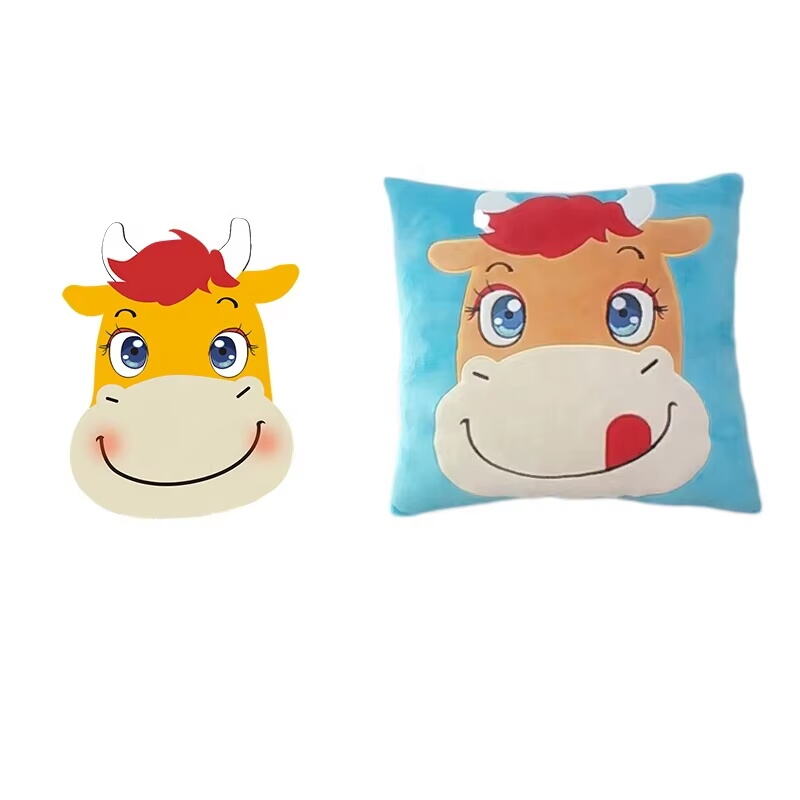Introduction to Plush Pillows
Plush pillows are basically soft, squishy cushions meant to support heads and necks when someone is trying to get some shut eye or just kick back. What makes them so appealing? Well, they really do help improve sleep quality most of the time, which means people wake up feeling refreshed instead of groggy. Think about those stuffed animals we all had as kids that gave us comfort and warmth at night. Plush pillows kind of work the same way but for adults. They bring that same cozy feeling right into our bedtime routines, making it easier to drift off and stay asleep through the night.
Mattresses are made from all sorts of materials, and each type brings something special to the table depending on what someone likes when they sleep. Cotton is pretty common because it lets air through and keeps things dry at night, while polyester stands out mainly for lasting longer and being cheaper overall. Sometimes manufacturers mix these together to create blends that try to get the best of both worlds soft enough but still tough on wear and tear. Then there's that super soft plush stuff everyone talks about so much lately. People who want their beds to feel like sleeping on clouds tend to go for this option since it really does deliver that fancy hotel bed experience most folks dream about.
Getting to know different types of plush pillows matters when picking out what works best for better sleep at night. When shopping around, look at things like what materials they're made from, how much support they offer, and whether they feel comfortable against your neck and head. Knowledge really helps here because it means creating a sleeping setup that actually promotes good rest instead of just tossing and turning all night long. Plus, knowing these details ensures whatever pillow ends up on your bed matches exactly what feels right for your body and sleeping habits over time.
Memory Foam: Comfort and Support
Benefits of Memory Foam
Memory foam pillows bring quite a few advantages to people who struggle with getting good sleep, mostly because they adapt so well and provide solid support. When someone lies down on one of these pillows, it actually molds around their head and neck, offering customized cushioning that takes pressure off those annoying spots where regular pillows just don't work right. This kind of tailored support makes a real difference in cutting down on morning aches and tightness that many folks get from using ordinary pillow types. Another big plus is how memory foam helps keep the spine properly aligned during sleep, which matters a lot when trying to wake up feeling refreshed rather than sore. The material itself tends to last longer too since it doesn't sink in as much from repeated use, making it pretty durable compared to other options out there. For anyone looking for something reliable that will hold up night after night while still giving great support, memory foam remains an excellent pick despite its higher price tag.
Best for Side and Back Sleepers
Memory foam pillows work really well for people who sleep on their sides or backs because of how they support different parts of the body. When someone sleeps on their side, these pillows fill in the space between shoulders and heads so there's less pressure on those areas, which helps keep the neck aligned properly during the night. Back sleepers get something similar but different too. The extra padding under their heads keeps their spines straighter while resting, reducing morning stiffness or pain in many cases. Research shows folks who switch to memory foam often report better nights' sleep overall. Some even notice waking up feeling more refreshed than before. That makes sense when considering all the ways these special materials adapt to individual shapes and needs across various sleeping positions throughout the night.
Polyester Fiberfill: Lightweight and Affordable
Why Choose Polyester Fiberfill?
For folks wanting soft, cozy pillows without breaking the bank, polyester fiberfill comes through pretty well. The price point means people on tighter budgets can still get comfortable seating or bedding solutions. A lot of shoppers who watch their spending tend to go for these polyester filled options since they actually feel decent compared to pricier alternatives. Plus, they're not heavy at all which makes them great for travel or moving around the house. Maintenance isn't too bad either. Just toss them in the washing machine and dryer and they usually keep their shape and springiness after multiple cycles. No need to worry about them flattening out permanently like some other materials might do over time.
Hypoallergenic Properties
Polyester fiberfill has one big plus going for it when it comes to people with allergies. The stuff just doesn't attract those pesky allergens that bother so many folks. For anyone dealing with seasonal sneezing or year-round sniffles, this makes polyester a smart pick. What really matters is how polyester stands up against mold and dust mites. These little troublemakers can't thrive in polyester environments, which means better air quality while sleeping. People who've switched to polyester filled bedding often report waking up feeling fresher. Consumer reports consistently show good feedback on these hypoallergenic options, which explains why so many health minded shoppers reach for polyester pillows over other materials.
Down and Down Alternative: Softness and Luxury
Luxury of Down Feathers
The softness of down feathers is simply unmatched, which explains why so many people reach for them when shopping for pillows. These feathers let air circulate well, helping regulate body temperature during the night and generally contributing to better sleep quality. We see this connection between down and luxury all over the place too. Think about five star hotels where guests expect nothing but the best, or upscale bedding collections sold at specialty stores. No wonder then that down pillows remain popular among folks who want both comfort and style in their bedroom setup.
Down Alternative for Allergies
Alternative down pillows give people all the softness they love about real goose down but without those pesky allergens that plague so many allergy sufferers. Made from synthetic fillings like polyester or memory foam blends, these pillows mimic the gentle feel of traditional down while staying hypoallergenic. Pillow makers have gotten pretty good at crafting options that stay warm without feeling heavy on the head, striking just the right balance between that dreamy cloud-like comfort everyone wants and actual practicality when it comes to daily use. The fact that sales keep climbing shows how well these alternatives are working for folks who need something gentle on their sinuses yet still want that luxurious pillow top feel during sleep.
Microfiber: Smooth and Soft Texture
Why Microfiber is Popular
People love microfiber because it feels so soft and smooth against the skin, which just makes everything more comfortable when using it. What's great about this stuff is that it manages to offer something expensive looking at a much lower price point, so all sorts of folks find themselves drawn to it. Since microfiber isn't heavy at all, it works wonders for daily activities around the house but backpackers appreciate it too since they don't want to carry extra weight while still wanting their sleeping bags to feel good. From pillowcases to bath towels, microfiber adapts to so many different situations, which explains why stores keep stocking up on these products despite having countless alternatives available.
Plush Feel of Microfiber
Microfiber gives that really nice, soft feeling similar to what people pay a lot more for in other bedding materials, yet still costs much less. Even though it feels so comfortable, this fabric actually holds up pretty well over time. After lots of washes, it doesn't fall apart or lose its shape like some cheaper fabrics do, which makes sense why so many households use it daily. The bedding market has seen a real boost in microfiber popularity lately because folks want something both comfy and practical at the same time. Many shoppers prefer microfiber these days since they get that fancy hotel bed experience without breaking the bank. For anyone looking for good quality bedding without spending a fortune, microfiber continues to be one of the best bets around.
Cotton and Silk Covers: Breathability and Luxury
Benefits of Cotton Covers
Cotton covers let air flow through them pretty well, which helps keep things cool when sleeping. People find these covers comfortable because they don't trap heat like other materials do, making them great for hot nights or summer months. Cotton is also good for folks who suffer from allergies since it doesn't irritate skin much compared to synthetic fabrics. Thread count matters too when picking out cotton covers. Lower numbers mean rougher fabric while higher counts tend to feel smoother against the skin. Most people go for around 200 threads per inch as a happy medium between comfort and practicality without spending extra cash on super expensive options that might not last longer anyway.
Luxury of Silk Covers
Silk pillow covers bring a bit of elegance to bedtime, transforming ordinary pillows into something special. Since they don't soak up as much moisture, skin stays naturally hydrated throughout the night, which is why so many people who care about their appearance gravitate toward them. The way silk feels against the face matters too it glides smoothly without tugging at skin or hair strands. Less friction means fewer split ends and those annoying morning creases that show up after sleeping on cotton. Some folks report waking up with smoother skin and stronger locks when switching to silk. While definitely on the pricier side compared to regular fabric options, most find the long term benefits justify the extra cost for what amounts to eight hours out of every day spent resting our heads.
FAQ
What materials are plush pillows made from?
Plush pillows are made from various materials, including cotton, polyester, memory foam, microfiber, and down, each offering unique features for different preferences.
Are memory foam pillows good for side and back sleepers?
Yes, memory foam pillows provide excellent support for both side and back sleepers, helping maintain spinal alignment and reducing discomfort.
Are polyester fiberfill pillows hypoallergenic?
Yes, polyester fiberfill pillows are hypoallergenic and resist allergens like mold and dust mites, making them ideal for allergy sufferers.
How do down alternative pillows compare with traditional down pillows?
Down alternative pillows offer the softness of natural down without allergens, making them suitable for those with allergies or sensitivities.
What are the advantages of using cotton or silk pillow covers?
Cotton covers provide breathability and hypoallergenic properties, while silk covers reduce skin friction and retain moisture for a luxurious sleep experience.


